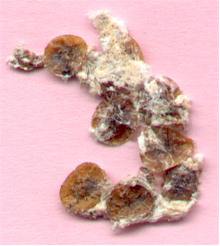 Common Name(s):
Common Name(s):Horse Chestnut Scale |
 Common Name(s):
Common Name(s):
Scientific Name(s):
Pulvinaria regalisType:
Insect
Principle Host Trees & Shrubs
: Most common on Sycamore (Acer pseudoplatanus) and Lime (Tilia). Also found on other broad-leaved trees including Magnolia and Horse Chestnut (Aesculus).
Description, Development & Diagnosis:
 Most
noticeable by the white spotted appearance of branches during the summer. The spots are in
fact the dead bodies of the female scale insect surrounded by a white waxy wool.
Most
noticeable by the white spotted appearance of branches during the summer. The spots are in
fact the dead bodies of the female scale insect surrounded by a white waxy wool.
The photograph opposite shows a close-up of the brown dead bodies of the female.
The females migrate to the bark of the branches and trunk during May where they can lay up to 3000 eggs. They protect their eggs with their bodies and a white wool which they secrete. The females die and eventually fall from the tree. Once the eggs hatch, the nymphs move onto the leaves to feed and then back to the twigs in winter to continue feeding until fully grown.
They are capable of reproducing without fertilisation from males.
Significance:
This disease is common and widespread. A large colony can reduce the vigour of the host tree.
Control:
Not recommended except on important, young, specimen trees. Spray the leaves and stems with an insecticide. The appearance of the bark can be improved by scrubbing with detergent.
| Further Information. |
© 2001 Chris Skellern. AIE. Home | News | A-Z Index | Resources | Contact AIE | Terms of Use